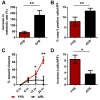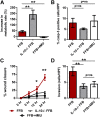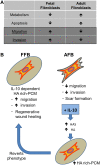The role of interleukin-10 and hyaluronan in murine fetal fibroblast function in vitro: implications for recapitulating fetal regenerative wound healing
- PMID: 25951109
- PMCID: PMC4423847
- DOI: 10.1371/journal.pone.0124302
The role of interleukin-10 and hyaluronan in murine fetal fibroblast function in vitro: implications for recapitulating fetal regenerative wound healing
Abstract
Background: Mid-gestation fetal cutaneous wounds heal scarlessly and this has been attributed in part to abundant hyaluronan (HA) in the extracellular matrix (ECM) and a unique fibroblast phenotype. We recently reported a novel role for interleukin 10 (IL-10) as a regulator of HA synthesis in the fetal ECM, as well as the ability of the fetal fibroblast to produce an HA-rich pericellular matrix (PCM). We hypothesized that IL-10-mediated HA synthesis was essential to the fetal fibroblast functional phenotype and, moreover, that this phenotype could be recapitulated in adult fibroblasts via supplementation with IL-10 via an HA dependent process.
Methodology/principal findings: To evaluate the differences in functional profile, we compared metabolism (MTS assay), apoptosis (caspase-3 staining), migration (scratch wound assay) and invasion (transwell assay) between C57Bl/6J murine fetal (E14.5) and adult (8 weeks) fibroblasts. We found that fetal fibroblasts have lower rates of metabolism and apoptosis, and an increased ability to migrate and invade compared to adult fibroblasts, and that these effects were dependent on IL-10 and HA synthase activity. Further, addition of IL-10 to adult fibroblasts resulted in increased fibroblast migration and invasion and recapitulated the fetal phenotype in an HA-dependent manner.
Conclusions/significance: Our data demonstrates the functional differences between fetal and adult fibroblasts, and that IL-10 mediated HA synthesis is essential for the fetal fibroblasts' enhanced invasion and migration properties. Moreover, IL-10 via an HA-dependent mechanism can recapitulate this aspect of the fetal phenotype in adult fibroblasts, suggesting a novel mechanism of IL-10 in regenerative wound healing.
Conflict of interest statement
Figures





Similar articles
-
Interleukin-10 regulates fetal extracellular matrix hyaluronan production.J Pediatr Surg. 2013 Jun;48(6):1211-1217. doi: 10.1016/j.jpedsurg.2013.03.014. J Pediatr Surg. 2013. PMID: 23845609 Free PMC article.
-
Interleukin-10-mediated regenerative postnatal tissue repair is dependent on regulation of hyaluronan metabolism via fibroblast-specific STAT3 signaling.FASEB J. 2017 Mar;31(3):868-881. doi: 10.1096/fj.201600856R. Epub 2016 Nov 30. FASEB J. 2017. PMID: 27903619 Free PMC article.
-
Interleukin-10 regulates the fetal hyaluronan-rich extracellular matrix via a STAT3-dependent mechanism.J Surg Res. 2013 Sep;184(1):671-7. doi: 10.1016/j.jss.2013.04.009. Epub 2013 Apr 24. J Surg Res. 2013. PMID: 23684616 Free PMC article.
-
Subpopulations of fetal-like gingival fibroblasts: characterisation and potential significance for wound healing and the progression of periodontal disease.Oral Dis. 1996 Jun;2(2):155-66. doi: 10.1111/j.1601-0825.1996.tb00217.x. Oral Dis. 1996. PMID: 8957929 Review.
-
[Hyaluronan: structure, metabolism, functions, and role in wound healing].Postepy Hig Med Dosw (Online). 2008 Dec 2;62:651-9. Postepy Hig Med Dosw (Online). 2008. PMID: 19057507 Review. Polish.
Cited by
-
Treatment of limb wounds of horses with orf virus IL-10 and VEGF-E accelerates resolution of exuberant granulation tissue, but does not prevent its development.PLoS One. 2018 May 15;13(5):e0197223. doi: 10.1371/journal.pone.0197223. eCollection 2018. PLoS One. 2018. PMID: 29763436 Free PMC article.
-
Lipid Emulsion Enriched in Omega-3 PUFA Accelerates Wound Healing: A Placebo-Controlled Animal Study.World J Surg. 2018 Jun;42(6):1714-1720. doi: 10.1007/s00268-017-4404-x. World J Surg. 2018. PMID: 29264725
-
RAGE and TGF-β1 Cross-Talk Regulate Extracellular Matrix Turnover and Cytokine Synthesis in AGEs Exposed Fibroblast Cells.PLoS One. 2016 Mar 25;11(3):e0152376. doi: 10.1371/journal.pone.0152376. eCollection 2016. PLoS One. 2016. PMID: 27015414 Free PMC article.
-
Regulator Versus Effector Paradigm: Interleukin-10 as Indicator of the Switching Response.Clin Rev Allergy Immunol. 2016 Feb;50(1):97-113. doi: 10.1007/s12016-015-8514-7. Clin Rev Allergy Immunol. 2016. PMID: 26450621 Review.
-
Emerging Role of IL-10 in Hypertrophic Scars.Front Med (Lausanne). 2020 Aug 27;7:438. doi: 10.3389/fmed.2020.00438. eCollection 2020. Front Med (Lausanne). 2020. PMID: 32974363 Free PMC article. Review.
References
-
- Adzick NS, Harrison MR, Glick PL, Beckstead JH, Villa RL, Scheuenstuhl H, et al. Comparison of fetal, newborn, and adult wound healing by histologic, enzyme-histochemical, and hydroxyproline determinations. Journal of pediatric surgery. 1985;20(4):315–9. Epub 1985/08/01. . - PubMed
-
- Rowlatt U. Intrauterine wound healing in a 20 week human fetus. Virchows Arch A Pathol Anat Histol. 1979;381(3):353–61. Epub 1979/03/23. . - PubMed
-
- Krummel TM, Nelson JM, Diegelmann RF, Lindblad WJ, Salzberg AM, Greenfield LJ, et al. Fetal response to injury in the rabbit. Journal of pediatric surgery. 1987;22(7):640–4. Epub 1987/07/01. . - PubMed
-
- Longaker MT, Whitby DJ, Adzick NS, Crombleholme TM, Langer JC, Duncan BW, et al. Studies in fetal wound healing, VI. Second and early third trimester fetal wounds demonstrate rapid collagen deposition without scar formation. Journal of pediatric surgery. 1990;25(1):63–8; discussion 8–9. Epub 1990/01/01. . - PubMed
-
- Mast BA, Haynes JH, Krummel TM, Cohen IK, Diegelmann RF. Ultrastructural analysis of fetal rabbit wounds. Wound repair and regeneration: official publication of the Wound Healing Society [and] the European Tissue Repair Society. 1997;5(3):243–8. Epub 1997/07/01. 10.1046/j.1524-475X.1997.50308.x . - DOI - PubMed
Publication types
MeSH terms
Substances
Grants and funding
LinkOut - more resources
Full Text Sources
Other Literature Sources
Medical
Research Materials

